The Ascent of Corsican Wines: A Feast of Distinctive Varieties and Terroirs by 5 Leading Producers. (8-Bottle Memorial Day Pack $269, All Included.)
If you took the wine savvy of France, blended it with the climate of the Italian Riviera and stirred in the heritage of Greece, you might think you’d just created the Valhalla of Viniculture—a test tube appellation with Goldilocks conditions where everything is just right.
And you’d be close. Corsica began producing wine half a century before Christ, when traders from Anatolia planted vines in Aléria on Corsica’s western shore. The island was sold to France in 1768, a year before the birth of history’s most famous Corsican, Napoléon Bonaparte. But despite this alignment of stars, up until recently, Corsica did not produce much wine of note. Until well into the twentieth century, the primary grape planted throughout the island’s multitude of microclimates was Sciaccarellu, a variety whose value is primarily as a blender—as a stand-alone, it produces a simple, strawberry-perfumed wine that rarely shows much sophistication. In the later years of the twentieth century, however, government subsidies began to convince growers to reduce the numbers of vines they tended, and by 2003, that canny largesse resulted in more than 17,000 vine acres being uprooted. Combined with modern techniques like temperature-controlled fermentation, a new Corsican winemaking mindset has begun to take hold. Indigenous grapes still rule, including Niellucciu, derived from the Corsican word for ‘black and dry’; a close cousin of Sangiovese, but today, the hot, dry and mountainous island is the home to some of Mediterranean’s most iconic and spectacular wines.
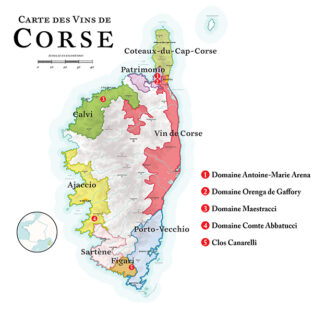 Many of them are labeled AOP (Appellation d’Origine Protégée) rather than AOC (Appellation d’Origine Contrôlée), the French designation of top quality. As legal guarantees (limited production area, compliance with specific production standards and established name recognition) the terms are pretty much interchangeable; they are simply awarded by different authorities. First created in France in 1905 and recognized internationally since 1958, ‘AOC’ as a label-dresser is gradually being supplanted by the Europe Union’s AOP. ‘Vin de Pays’ is also being phased out in favor of the EU’s IGP (Indication Géographique Protégée), a term that covers wine from a designated area. In some cases, they are as good or better than AOP wines, but produced according to standards that may stray the strict regulations of AOP/AOC.
Many of them are labeled AOP (Appellation d’Origine Protégée) rather than AOC (Appellation d’Origine Contrôlée), the French designation of top quality. As legal guarantees (limited production area, compliance with specific production standards and established name recognition) the terms are pretty much interchangeable; they are simply awarded by different authorities. First created in France in 1905 and recognized internationally since 1958, ‘AOC’ as a label-dresser is gradually being supplanted by the Europe Union’s AOP. ‘Vin de Pays’ is also being phased out in favor of the EU’s IGP (Indication Géographique Protégée), a term that covers wine from a designated area. In some cases, they are as good or better than AOP wines, but produced according to standards that may stray the strict regulations of AOP/AOC.
These five Corsican producers are leading the pack in terms of quality over quantity. The 8-bottle pack ($269, All Included) is just in time for your holiday libation. It includes two of Domaine Maestracci’s, two of each of Domaine Orenga de Gaffory’s white and red, and one each of Domaine Abbatucci and Clos Canarelli. Domaine Arena’s Muscat is specially priced and isn’t part of the package.
Domaine Orenga de Gaffory
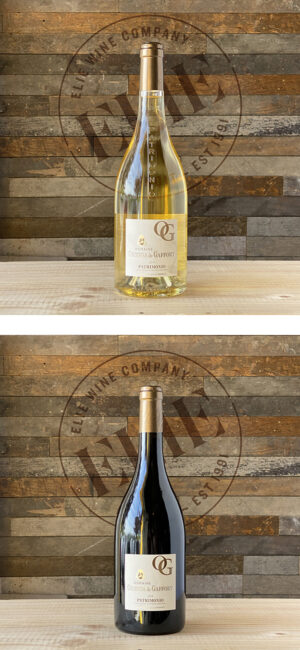 In parcels between the towns of Saint-Florent and Poggio-d’Oletta in the beautiful Patrimonio appellation in northern Corsica, Henri Orenga de Gaffory has been exploring unique terroirs since 1966. Finding them best expressed in traditional varietals, he dedicates his 150 acres to raising limited-yield Niellucciu, Vermentinu, Minustellu, Aleatico, Muscat and of course, the standby blending red, Sciaccarellu. Wine folks are familiar with at least a couple of them, but as to the rest, would be hard-pressed to bet on whether they were white or red. Here’s your hint: AOP Patrimonio 2019 White ($22) is 100% Vermentinu, grown in soils that are an equal blend of limestone, chalk and clay. It has an electric lemon-lime palate behind a white-flower bouquet tinged with brine. With another year of aging, honeyed wax notes will become more pronounced. AOP Patrimonio 2018 Red ($20) demonstrates the same terroir’s expression of Niellucciu—a native grape that must, by Patrimonio law, make up 90% of the blend with the balance in Grenache. It’s a robust and silky wine displaying fruits, peppery spice and licorice, tinged with mineral throughout.
In parcels between the towns of Saint-Florent and Poggio-d’Oletta in the beautiful Patrimonio appellation in northern Corsica, Henri Orenga de Gaffory has been exploring unique terroirs since 1966. Finding them best expressed in traditional varietals, he dedicates his 150 acres to raising limited-yield Niellucciu, Vermentinu, Minustellu, Aleatico, Muscat and of course, the standby blending red, Sciaccarellu. Wine folks are familiar with at least a couple of them, but as to the rest, would be hard-pressed to bet on whether they were white or red. Here’s your hint: AOP Patrimonio 2019 White ($22) is 100% Vermentinu, grown in soils that are an equal blend of limestone, chalk and clay. It has an electric lemon-lime palate behind a white-flower bouquet tinged with brine. With another year of aging, honeyed wax notes will become more pronounced. AOP Patrimonio 2018 Red ($20) demonstrates the same terroir’s expression of Niellucciu—a native grape that must, by Patrimonio law, make up 90% of the blend with the balance in Grenache. It’s a robust and silky wine displaying fruits, peppery spice and licorice, tinged with mineral throughout.
Domaine Orenga de Gaffory
Domaine Maestracci
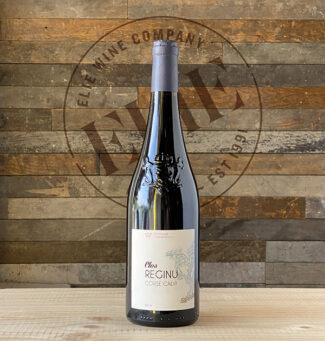 Inland from Calvi, the granite plateau of Reginu provides a microclimate known in Corsica as ‘U Vinu di E Prove’. Conditions there are familiar (and ideal) to those who understand diurnal shifts as it relates to the production of fine wine. Daytime temperatures rise to sweltering heights, but nights are high-elevation cool; the combined effects develop the sugar and stubbornly hold onto the ripening fruit’s natural acidity. On the estate of an old olive grove, Roger Maestracci saw an opportunity for vineyards; essentially the only two crops which thrive under these conditions are olive trees and grape vines. The estate is now run by his granddaughter, Camille-Anaïs Raoust, who refers to ‘Clos Reginu’ AOP Corse Calvi 2019 ($19) affectionately as ‘Clos Reggie’. It is a blend of grapes that may have been unfamiliar to you before tasting through this package, but which may have become new friends: 30% Niellucciu, 30% Grenache, 15% Sciaccarellu, 15% Syrah, 5% Mourvèdre and 5% Carignan. It is a juicy, spicy, herb-scented, mouthwatering red wine that can serve as the foundation to any summer meal enjoyed outside.
Inland from Calvi, the granite plateau of Reginu provides a microclimate known in Corsica as ‘U Vinu di E Prove’. Conditions there are familiar (and ideal) to those who understand diurnal shifts as it relates to the production of fine wine. Daytime temperatures rise to sweltering heights, but nights are high-elevation cool; the combined effects develop the sugar and stubbornly hold onto the ripening fruit’s natural acidity. On the estate of an old olive grove, Roger Maestracci saw an opportunity for vineyards; essentially the only two crops which thrive under these conditions are olive trees and grape vines. The estate is now run by his granddaughter, Camille-Anaïs Raoust, who refers to ‘Clos Reginu’ AOP Corse Calvi 2019 ($19) affectionately as ‘Clos Reggie’. It is a blend of grapes that may have been unfamiliar to you before tasting through this package, but which may have become new friends: 30% Niellucciu, 30% Grenache, 15% Sciaccarellu, 15% Syrah, 5% Mourvèdre and 5% Carignan. It is a juicy, spicy, herb-scented, mouthwatering red wine that can serve as the foundation to any summer meal enjoyed outside.
Domaine Maestracci
Domaine Comte Abbatucci
 In Corsica, the name ‘Abbatucci’ is seen as frequently as Washington in the United States, and for much the same reason—General Charles Abbatucci (from Ajaccio) was a hero of the French Revolution. The Domaine that bears the name is run by a direct descendent of the General, Jean-Charles Abbatucci. A fanatical exponent of the most eccentric of biodynamic techniques, the names of his blends are as flamboyant as the product behind the label—‘Cuvée Collection – Ministre Impérial’ Vin de France 2016 ($89) is composed of 22% Sciaccarellu, 18% Niellucciu, 15% Carcajolu-Neru, 15% Montanaccia, 12% Morescono, 10% Morescola and 8% Aleatico, drawing nuances from each of these fascinating varieties. Named for a leading military figure under Napoléon Bonaparte’s Premier Empire (who then became a consul under Napoléon III) the grapes are crushed by foot and macerated for 15 days before being aged in 600-liter demi-muids. The nose is an exotic combination of flower perfumes and exotic berry spice, and the wine unfolds with complexity, intensity and richness, with flavors of bramble fruits, cola, garrigue, good acidity and a backbone of toasted oak.
In Corsica, the name ‘Abbatucci’ is seen as frequently as Washington in the United States, and for much the same reason—General Charles Abbatucci (from Ajaccio) was a hero of the French Revolution. The Domaine that bears the name is run by a direct descendent of the General, Jean-Charles Abbatucci. A fanatical exponent of the most eccentric of biodynamic techniques, the names of his blends are as flamboyant as the product behind the label—‘Cuvée Collection – Ministre Impérial’ Vin de France 2016 ($89) is composed of 22% Sciaccarellu, 18% Niellucciu, 15% Carcajolu-Neru, 15% Montanaccia, 12% Morescono, 10% Morescola and 8% Aleatico, drawing nuances from each of these fascinating varieties. Named for a leading military figure under Napoléon Bonaparte’s Premier Empire (who then became a consul under Napoléon III) the grapes are crushed by foot and macerated for 15 days before being aged in 600-liter demi-muids. The nose is an exotic combination of flower perfumes and exotic berry spice, and the wine unfolds with complexity, intensity and richness, with flavors of bramble fruits, cola, garrigue, good acidity and a backbone of toasted oak.
Domaine Comte Abbatucci
Clos Canarelli
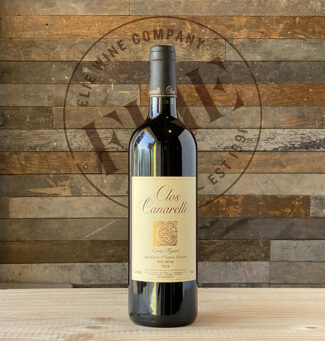 Yves Canarelli left a career in economics to return to his family’s wine estate on the somewhat brutal southern tip of Corsica, where temperatures have been known to soar to 109°F and rainfall rarely exceeds thirty inches annually; in the Figari appellation, the soil is essentially a sparse dusting of granitic red alluvia. Canarelli has championed the return of native varietals, which thrive in there in such conditions; he is one of the pioneers who advocated tearing out foreign grapes in favor of those first planted in Corsica since Phoenician times. Likewise, he uses only indigenous yeasts, and prefers slow, deliberate, precise fermentations, then leaves his reds unfiltered. AOP Corse Figari Rouge 2016 ($45) is a blend of 80% Niellucciu, 15% Syrah and 5% Sciaccarellu; it delivers a bold and intense presentation redolent of black cherry and dried blackberry with sweet almond, toasted spice and balsam in the finish.
Yves Canarelli left a career in economics to return to his family’s wine estate on the somewhat brutal southern tip of Corsica, where temperatures have been known to soar to 109°F and rainfall rarely exceeds thirty inches annually; in the Figari appellation, the soil is essentially a sparse dusting of granitic red alluvia. Canarelli has championed the return of native varietals, which thrive in there in such conditions; he is one of the pioneers who advocated tearing out foreign grapes in favor of those first planted in Corsica since Phoenician times. Likewise, he uses only indigenous yeasts, and prefers slow, deliberate, precise fermentations, then leaves his reds unfiltered. AOP Corse Figari Rouge 2016 ($45) is a blend of 80% Niellucciu, 15% Syrah and 5% Sciaccarellu; it delivers a bold and intense presentation redolent of black cherry and dried blackberry with sweet almond, toasted spice and balsam in the finish.
Clos Canarelli
Domaine Antoine-Marie Arena
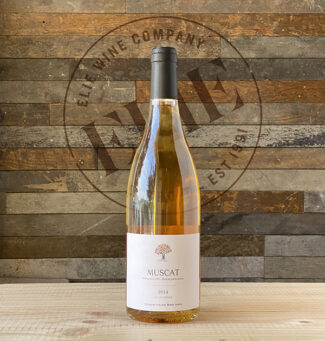 When legendary Corsican producer Antoine Arena split his Patrimonio estate into sections, each of his sons got a piece. To his parcel, Antoine-Marie brought not only experience from his native Ile de Beauté, but his enological and viticultural studies in Hyères as well as internships in both Burgundy and Provence. He explains, “Working as a family is great, but the Corsican spirit of liberty and independence guided us in this decision.” Fulfilling both ideals, he constructed his new wine cellar across from the family home and has begun own legacy with a series of remarkable releases from the vineyard Morta Maìo—translated as ‘The Eldest Myrtle’, referencing the myrtle shrub found throughout Corsica. ‘Morta Maìo’ Muscat, Vin de France 2014 (Sweet White) ($50) is from Antoine-Marie’s first solo vintage, and shows the complexity of Muscat as a dessert wine; notes of sultana and apricot underscore silky peach and luscious beeswax, and in the finish, candied orange and bergamot. The wine is referred to as ‘non-mute’ or ‘vin doux naturel’ which in the parlance of the craft means that no alcohol is added; the 13.5% ABV comes entirely from natural grape sugars.
When legendary Corsican producer Antoine Arena split his Patrimonio estate into sections, each of his sons got a piece. To his parcel, Antoine-Marie brought not only experience from his native Ile de Beauté, but his enological and viticultural studies in Hyères as well as internships in both Burgundy and Provence. He explains, “Working as a family is great, but the Corsican spirit of liberty and independence guided us in this decision.” Fulfilling both ideals, he constructed his new wine cellar across from the family home and has begun own legacy with a series of remarkable releases from the vineyard Morta Maìo—translated as ‘The Eldest Myrtle’, referencing the myrtle shrub found throughout Corsica. ‘Morta Maìo’ Muscat, Vin de France 2014 (Sweet White) ($50) is from Antoine-Marie’s first solo vintage, and shows the complexity of Muscat as a dessert wine; notes of sultana and apricot underscore silky peach and luscious beeswax, and in the finish, candied orange and bergamot. The wine is referred to as ‘non-mute’ or ‘vin doux naturel’ which in the parlance of the craft means that no alcohol is added; the 13.5% ABV comes entirely from natural grape sugars.
Domaine Antoine-Marie Arena
- - -
Posted on 2021.06.01 in France, Corsica
Featured Wines
- Notebook: A’Boudt Town
- Saturday Sips Wines
- Saturday Sips Review Club
- The Champagne Society
- Wine-Aid Packages
Wine Regions
Grape Varieties
Aglianico, Albarino, Albarín Blanco, Albarín Tinto, Albillo, Aleatico, Arbanne, Aubun, Barbarossa, barbera, Beaune, Biancu Gentile, bourboulenc, Cabernet Franc, Cabernet Sauvignon, Caino, Caladoc, Calvi, Carcajolu-Neru, Carignan, Chablis, Chardonnay, Chasselas, Clairette, Corvina, Cot, Counoise, Erbamat, Ferrol, Fiano, Frappato, Friulano, Fromenteau, Fumin, Garnacha, Gewurztraminer, Godello, Graciano, Grenache, Grolleau, Groppello, Juan Garcia, Lambrusco, Loureira, Macabeo, Macabou, Malvasia, Malvasia Nera, Marsanne, Marselan, Marzemino, Melon de Bourgogne, Merlot, Mondeuse, Montanaccia, Montepulciano, Morescola, Morescono, Moscatell, Muscadelle, Muscat, Natural, Nero d'Avola, Parellada, Patrimonio, Petit Meslier, Petit Verdot, Pineau d'Aunis, Pinot Auxerrois, Pinot Blanc, Pinot Gris, Pinot Meunier, Pinot Noir, Poulsard, Prieto Picudo, Rondinella, Rousanne, Roussanne, Sangiovese, Sauvignon Blanc, Savignin, Semillon, Souson, Sparkling, Sumoll, Sylvaner, Syrah, Tannat, Tempranillo, Trebbiano, Trebbiano Valtenesi, Treixadura, Trousseau, Ugni Blanc, vaccarèse, Verdicchio, Vermentino, Viognier, Viura, Xarel-loWines & Events by Date
- April 2024
- March 2024
- February 2024
- January 2024
- December 2023
- November 2023
- October 2023
- September 2023
- August 2023
- July 2023
- June 2023
- May 2023
- April 2023
- March 2023
- February 2023
- January 2023
- December 2022
- November 2022
- October 2022
- September 2022
- August 2022
- July 2022
- June 2022
- May 2022
- April 2022
- March 2022
- February 2022
- January 2022
- December 2021
- November 2021
- October 2021
- September 2021
- August 2021
- July 2021
- June 2021
- May 2021
- April 2021
- March 2021
- February 2021
- January 2021
- December 2020
- November 2020
- October 2020
- September 2020
- August 2020
- July 2020
- June 2020
- May 2020
- April 2020
- March 2020
- February 2020
- January 2020
- December 2019
- November 2019
- October 2019
- September 2019
- August 2019
- July 2019
- June 2019
- May 2019
- April 2019
- March 2019
- February 2019
- January 2019
- December 2018
- November 2018
- October 2018
- September 2018
- August 2018
- July 2018
- June 2018
- May 2018
- April 2018
- March 2018
- February 2018
- January 2018
- December 2017
- November 2017
- October 2017
- September 2017
- August 2017
- July 2017
- June 2017
- May 2017
- April 2017
- March 2017
- February 2017
- January 2017
- December 2016
- November 2016
- October 2016
- September 2016
- August 2016
- July 2016
- June 2016
- May 2016
- April 2016
- March 2016
- February 2016
- January 2016
- December 2015
- November 2015
- October 2015
- September 2015
- August 2015
- July 2015
- June 2015
- May 2015
- April 2015
- March 2015
- February 2015
- January 2015
- December 2014
- November 2014
- October 2014
- September 2014
- August 2014
- July 2014
- June 2014
- April 2014
- March 2014
- February 2014
- January 2014
- December 2013
- November 2013
- October 2013
- September 2013
- August 2013
- July 2013
- June 2013
- May 2013
- April 2013
- March 2013
- February 2013
- January 2013
- December 2012
- November 2012
- October 2012
- February 2004
Search



